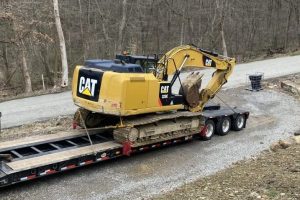 Transporting an excavator is no small feat. These heavy-duty machines can weigh over 45 tons and are essential for a wide range of construction and excavation tasks. Whether you need to transport an excavator for maintenance or to a new job site, it’s important to understand the process and costs involved. In this comprehensive guide, we’ll explore the different types of excavators, permits required for hauling, the best trailers for shipping, and tips for safe transportation.
Transporting an excavator is no small feat. These heavy-duty machines can weigh over 45 tons and are essential for a wide range of construction and excavation tasks. Whether you need to transport an excavator for maintenance or to a new job site, it’s important to understand the process and costs involved. In this comprehensive guide, we’ll explore the different types of excavators, permits required for hauling, the best trailers for shipping, and tips for safe transportation.
Types of Excavators for Transport
Excavators come in various types, each with its own functions and capabilities. Here are some of the most common types of excavators used in the industry:
Crawler Excavators: Crawler excavators are widely used in heavy-duty construction and mining. They are equipped with steel tracks that allow them to navigate uneven terrain and scale hills. These excavators are ideal for digging large holes, moving earth, and demolishing existing structures.
Dragline Excavators: Dragline excavators utilize a rope system to lift and move debris. They are commonly used in civil engineering projects such as road and port construction, as well as pond and canal dredging. Some dragline excavators can be dismantled for easier transportation on flatbed trailers.
Skid Steer Excavators: Skid steer excavators are smaller in size and feature different steering systems for each wheel pair. This allows them to operate independently and at different speeds. Skid steer excavators are best suited for narrow areas like residential neighborhoods or transporting raw materials within a construction site.
Vacuum Excavators: Vacuum excavators, also known as suction excavators, utilize powerful suction through a wide pipe to clear up loosened earth, debris, and litter. They are more precise and less damaging to the surrounding environment, making them suitable for delicate underground construction sites.
Long Reach Excavators: Long reach excavators have extendable arms that can reach over 100 feet horizontally. These excavators are used for dredging and industrial demolition, as their extended reach allows them to safely tear down structures starting with the upper stories.
Permits Required for Excavator Hauling
Transporting an excavator can involve various logistical and administrative challenges. Depending on the size, route, and destination of the haul, you may need to obtain permits to comply with state regulations for oversized loads. When crossing state lines, multiple permits may be required, and escorts or specialized paperwork might be necessary. To ensure a smooth and compliant transport, it is advisable to work with heavy load shipping experts who are familiar with the regulations and can handle the necessary paperwork.
Choosing the Right Trailer for Excavator Shipping
Selecting the appropriate trailer is crucial for safe and efficient excavator transportation. In most cases, a flatbed trailer is the preferred choice. However, the size and height of the excavator will determine the specific type of trailer needed. Lowboy trailers are commonly used as they can accommodate the tall size and heavy weight of excavators. Trailers with a higher number of axles have greater hauling capacities, often reaching up to 80,000 lbs in some states.
Loading an excavator onto a trailer requires careful maneuvering. To ensure safe shipping, the excavator must be securely fastened using heavyweight chains and boomers. The heaviest side of the excavator should be loaded first onto the trailer, and the equipment should be properly secured with tie-down equipment and points. Before transportation, all articulation points, such as pivots or hinges, as well as doors and covers, should be locked.
Tips for Safe Excavator Transportation
To ensure a successful and secure excavator transportation, consider the following tips:
Choose a level and sturdy ground: Load the excavator onto the trailer on a level and stable surface. Clear the pathway of any debris or grease to ensure a smooth loading process.
Plan the loading sequence: Load the heaviest side of the excavator onto the trailer first. This will help maintain balance during transportation.
Secure the equipment: Use appropriate tie-down equipment and tie-down points to secure the excavator to the trailer. Ensure that all articulation points, doors, and covers are locked.
Check tire inflation: Before transportation, check that the excavator’s tires are correctly inflated and free from leaks. This will help ensure that the tie-downs remain secure throughout the journey.
Transporting an excavator requires careful planning, adherence to regulations, and the use of specialized equipment. To ensure a smooth and safe delivery, it is recommended to work with a freight transportation company experienced in handling oversized loads. Their team of experts can handle the logistics, paperwork, and provide the necessary equipment to transport excavators of all sizes. Request a quote today to receive a personalized and competitive estimate for your excavator shipping needs.
Contact Us (859) 824-4177 for more information or to get a quote!
—

About American Lighthouse Transportation
American Lighthouse Transportation has been serving shippers with honesty and integrity throughout the United States, since 1998. You can depend on our experienced and knowledgeable management team, drivers, and support for all your shipping needs. We communicate effectively to make sure your shipment arrives safely, accurately, and on-time! You can count on us for personalized customer service, expert guidance, accurate anticipation of potential setbacks, and possible workarounds and solutions.
>> Learn More